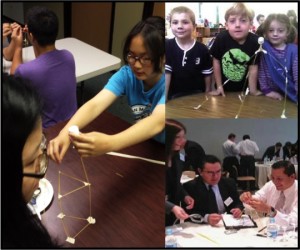Last summer our students took part in “The Marshmallow Challenge” during our Summer Immersion Program. The challenge is simple: “in eighteen minutes, teams must build the tallest free-standing structure out of 20 sticks of spaghetti, one yard of tape, one yard of string, and one marshmallow. The marshmallow needs to be on top.” Consistently, the worst performing groups are the business school students and lawyers (about 10-15 inches tall), while one of the best performing groups tend to be recent kindergarten graduates (25+ inches).

So why is that?
Most adults versed in problem solving would approach their 18-minute challenge this way: spend first six minutes orienting themselves and planning, the next ten minutes building and executing their plan, and in the last two minutes put the marshmallow on the top. They go into a frenzy panic when they learn that their structure can’t hold up the marshmallow.
Kindergarteners, on the other hand, start with the marshmallow, try something (in the first five minutes), find out it doesn’t work, and try it a different way. They go through many “trial-error-revision cycles” during their 18 minutes, refining their prototype each time.
Research supports this idea that students learn best through the “trial-error-revision cycles.” What is essential in this cycle is taking the time to reflect on what they have learned through their trials and errors before setting new goals. As students transition to a new year and a new semester, taking the time to reflect will reinforce what they have learned, improve their problem-solving skills and learning strategies (Slavin, 2012, p. 150), and build some of their “softer skills” of learning, such as self-directed learning and collaboration (Hmelo-Silver, Duncan, & Chin, 2007, p. 105).
Here are some practical things parents and teachers can do to help students reflect on their learning:
- Parents and teachers can start by helping students evaluate their learning against their goals (what they have actually learned versus what they had hoped to learn). More advanced students can take this reflection a step further and evaluate their learning against the teacher’s objectives (what the students learned versus what the teacher hoped they would learn). Such self-reflection allows the students to move beyond learning as a checklist of knowledge to making sense and application of their learning (Kuhn, 2007 & Flum and Kaplan, 2006).
- Next, help the students see that their learning goals are not static but can grow and change through reflecting on what they have learned. Evolving goals can lead to increased confidence and skills. Carol Dweck’s research on “Growth Mindset versus Fixed Mindset” highlights the value of having the attitude that our minds can grow to be smarter and better, and the impact of such a mindset on a student’s motivation (and results).
- Last but not least, celebrate your students’ small wins together! Have the students reflect on what they did well – specifically on the efforts they put towards achieving their goals (the process), regardless of the outcome. Praise them for the ways they tried, retried, and retried. Help them recognize it and celebrate it.
Setting goals for a specific outcome is important. But perhaps more important would be reflecting on their attitudes and progress along the way. Instead of thinking about “what will I do IF I mess up?” we should teach our students to think about the inevitable “what will I do WHEN I mess up?”
Helping students reflect on their “failures” as learning opportunities — understanding what “doesn’t work” is vital — will enable them to iterate better approaches the next time. The result can be a strong foundation for future learning — and a structure that will hold the marshmallow without collapsing.